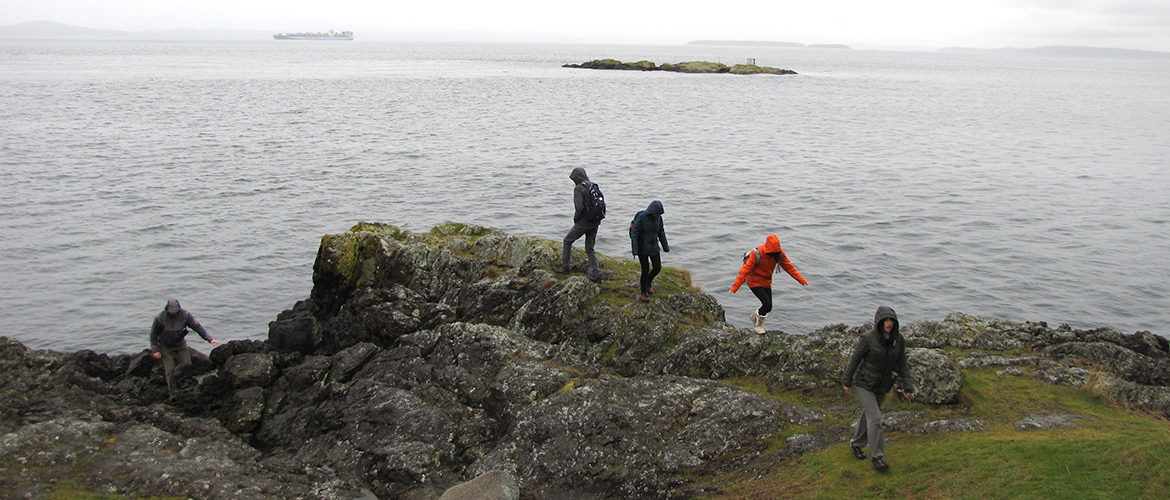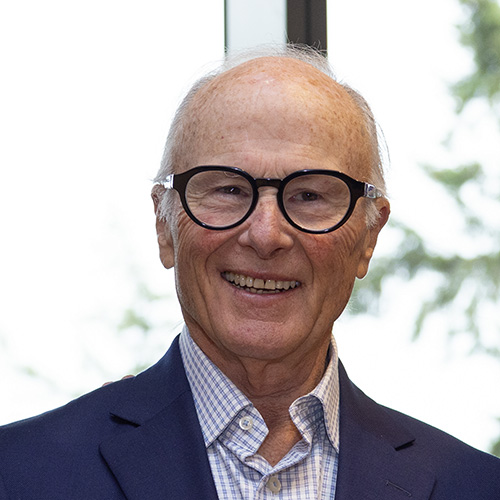For some people, shorelines are places to sit and admire a sunset. For others, they are fascinating ecological or geological zones. For Cleo Woelfle-Erskine and July Hazard, shorelines are all of this and more.
“Shorelines are one of the most interesting places for both of us,” says Hazard, lecturer in the Comparative History of Ideas (CHID) program. “They are interesting as transitional areas, as changing areas, as places where things wash up and things wear away. The sounds of the shoreline are a mix of the waves and the rocky beach. The voices are combined voices.”
Hazard and Woelfle-Erskine, assistant professor of equity and environmental justice in the School of Marine & Environmental Affairs (SMEA), have turned their fascination with shorelines into a UW course, Ecopoetics Along Shorelines. Offered this spring by SMEA, CHID, and the Honors Program, the course has attracted a diverse group of students, from freshmen to PhD students in fields ranging from creative writing to physics to environmental affairs.

The course began over spring break with a field intensive on Washington’s San Juan Island, and continues spring quarter with a weekly seminar on the Seattle campus. During the field intensive, Hazard and Woelfle-Erskine helped students gain an understanding of historical and ecological dynamics of the landscape through careful observation. “We wanted to train them in the practices of seeing and observing, to read the landscape in a way that students might be more familiar with reading a text,” says Woelfle-Erskine.
Guest speakers included scientists at Friday Harbor Laboratories (FHL), as well as a Swinomish Indian Tribal Community elder and the director of the Samish Indian Nation’s Department of Natural Resources. For SMEA masters student Julie Ann Koehlinger, the talk at Swinomish was a highlight. “That visit started me thinking about community, and what it means to define community in a way that removes much of the individualistic aspect that our dominant culture deems so vital,” she says. “It’s something I’m going to wrestle with for a while.”
FHL director Billie Swalla, a UW professor of biology, also joined the class as a guest speaker. During a visit to San Juan Island’s False Bay, which transforms to a mudflat at low tide, Swalla pointed out how mud patches just ten feet apart can vary in color and texture and host different animal communities. “Students got a sense of Billie’s intimate knowledge of the space,” says Woelfle-Erskine. “She spoke for just about 45 minutes, but it really set the context for the students, who then spent hours watching the tide empty completely over the course of the morning.”

As the tide receded, the students wrote in field journals — as they did every morning during field trips and again before a late-afternoon seminar. Sometimes they wrote in response to site-related prompts posed by Hazard and Woelfle-Erskine; other times the writing was inspired by their surroundings. “Field writing is a tradition across so many disciplines,” says Hazard, who has graduate degrees in both environmental studies and poetry. “We wanted students from many backgrounds to feel like writing was part of their specialty already and they were just expanding it — learning different approaches, different ways of paying attention.”
We wanted to train them...to read the landscape in a way that students might be more familiar with reading a text.
In the evening, the class gathered to share their day’s writing. For some, that took getting used to. “At first I felt like I had to write a specific way,” says physics major Alex McGoldrick, an Interdisciplinary Honors student. “Over time, I eased into writing in a style more akin to myself and relaxed a lot more. I would get these random ideas and would immediately pull out my journal to write a full passage or sketch a particular sight. For me, following these random tangents produced the best writing.”
Koehlinger, who normally tends toward academic or scientific writing, welcomed the opportunity to write without constraints. “Approaching writing from a more creative and less structured way was a great way to get out of my head,” she says. “As a scientist, I’m also searching for new ways to communicate with non-scientists. I think that scientists need to embrace more out-of-the-box thinking and incorporation of creative processes.”

All fifteen students from the field intensive, plus six additional students, are now in the spring quarter seminar, where they are continuing to explore themes introduced in the field. Their readings range from poetry to historical and scientific documents, and they continue to visit shorelines — this time at the edge of campus — for field writing. Guest speakers include a recent Washington State poet laureate, an orca researcher at NOAA, and a scientist affiliated with the Waterlines Project, who offer perspectives as diverse as those of the students.
Well, almost as diverse.
“With this group, we have such a wide range of lenses through which we view nature,” says Kayla Carrington, a fourth-year undergraduate majoring in Community, Environment & Planning (CEP), and Environmental Studies, Honors. “Some students are science and research focused, some see landscapes through the lens of Indigenous history, while some contemplate psychology and philosophy. It really is illuminating to see how different minds perceive and articulate the environments around them. When we put these perspectives into conversation, we are challenged to broaden our own.”
. . .
For more about Ecopoetics Along Shorelines, including student writing and the course syllabus, visit shorelinepoetics.com.
More Stories

A Healing Heart Returns
In February, the UW Symphony will perform a symphony that Coast Salish elder Vi Hilbert commissioned years ago to heal the world after the heartbreak of 9/11. The symphony was first performed by the Seattle Symphony in 2006.

Need a break from holiday movies? Try these
For those wanting a break from holiday movies, Cinema & Media Studies faculty and grad students offer suggestions.

A Transformative Gift for Arts & Sciences
To honor his wife and support the college that has meant so much to both of them, former Arts & Sciences dean John Simpson created the Katherine and John Simpson Endowed Deanship.